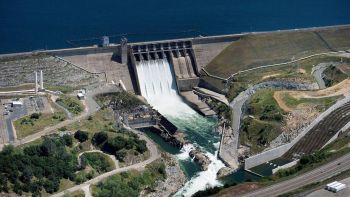Composite Dams: Difference between revisions
Rmanwaring (talk | contribs) No edit summary |
No edit summary |
||
| Line 1: | Line 1: | ||
__NOTOC__ | __NOTOC__ | ||
---- | ---- | ||
{{Picture | |||
|image= | |||
<!-- Add image file name (ex.image.jpg) --> | |||
composite-folsom.jpg | |||
|link= | |||
<!--Add link if applicable --> | |||
|caption= | |||
<!-- Add picture caption --> | |||
Folsom Dam, located just outside the city of Folsom, California northeast of Sacramento, is comprised of a central concrete spillway flanked on either side by earthen wing dams. | |||
}} | |||
Composite dams are designed and constructed using both earth embankment and concrete sections. The most common type of composite dam is a combination of concrete and embankment structures. It is common in composite dams to construct the outlet works, necessary hydropower structures, spillway (either gated or uncontrolled), and stilling basin as either part of or connected to, the concrete portion of the dam. | Composite dams are designed and constructed using both earth embankment and concrete sections. The most common type of composite dam is a combination of concrete and embankment structures. It is common in composite dams to construct the outlet works, necessary hydropower structures, spillway (either gated or uncontrolled), and stilling basin as either part of or connected to, the concrete portion of the dam. | ||
Revision as of 20:31, 8 September 2022

|
| Folsom Dam, located just outside the city of Folsom, California northeast of Sacramento, is comprised of a central concrete spillway flanked on either side by earthen wing dams. |
Composite dams are designed and constructed using both earth embankment and concrete sections. The most common type of composite dam is a combination of concrete and embankment structures. It is common in composite dams to construct the outlet works, necessary hydropower structures, spillway (either gated or uncontrolled), and stilling basin as either part of or connected to, the concrete portion of the dam.
The earth embankment portion(s) of the dam, including any necessary saddle dams, are typically greater in volume than the concrete section(s), reducing the overall cost of the structure and preventing internal erosion along conduits and other concrete structures that would typically be built in and underneath a dam constructed entirely of an embankment. Additionally, issues with internal erosion and piping that often occur as a result of constructing conduits and other concrete structures through and underneath earthen embankment dams are minimized, since these structures are contained within the concrete section(s) of the dam. Special care is taken during design and construction to prevent seepage and internal erosion between earthen embankment section and concrete section interface(s).
Revision ID: 2531
Revision Date: 09/08/2022
